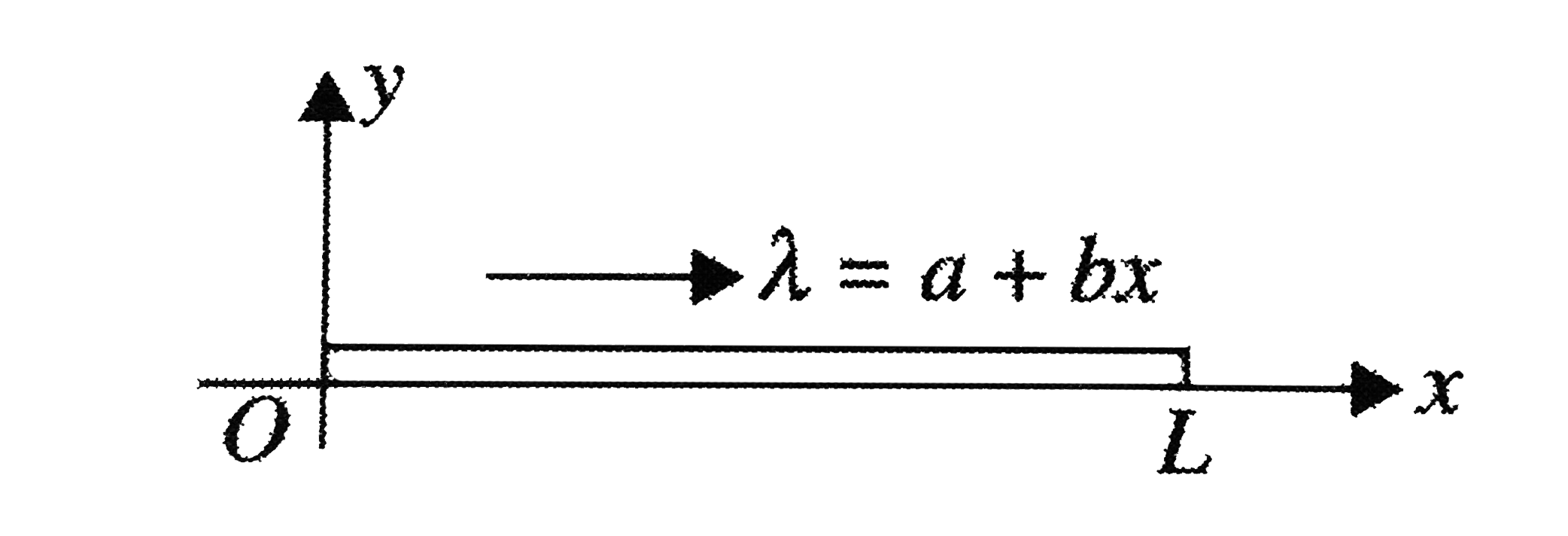The linear mass density lambda of a rod AB is given by λ=aplha+βxkgm taking O as origin. Find the location of the centre of mass from the end A?
To find the location of the center of mass of a rod AB with a linear mass density given by λ=α+βx kg/m, we can follow these steps:
1. Understand the Problem:
The linear mass density of the rod varies along its length. We need to find the center of mass from one end (point A) of the rod.
2. Define the Length of the Rod:
Let the length of the rod be L. We will take the rod to extend from x=−L2 to x=L2.
3. Express the Mass Element:
The mass element dm of a small segment dx of the rod can be expressed as:
dm=λdx=(α+βx)dx
4. Set Up the Center of Mass Formula:
The center of mass xcm for a continuous mass distribution is given by:
xcm=∫xdm∫dm
Substituting dm:
xcm=∫L2−L2x(α+βx)dx∫L2−L2(α+βx)dx
5. Calculate the Numerator:
For the numerator:
∫L2−L2x(α+βx)dx=∫L2−L2(αx+βx2)dx
This can be split into two integrals:
=α∫L2−L2xdx+β∫L2−L2x2dx
The first integral ∫L2−L2xdx=0 (since it is symmetric about the origin). The second integral is:
∫L2−L2x2dx=(x33)L2−L2=13((L2)3−(−L2)3)=13(L38+L38)=L312
Thus, the numerator becomes:
=β⋅L312
6. Calculate the Denominator:
For the denominator:
∫L2−L2(α+βx)dx=α∫L2−L2dx+β∫L2−L2xdx
The first integral is:
∫L2−L2dx=L
The second integral is zero. Thus, the denominator becomes:
=αL
7. Combine the Results:
Now substituting back into the center of mass formula:
xcm=β⋅L312αL=βL212α
8. Adjust for the Position from Point A:
Since the center of mass is calculated from the center of the rod, we need to adjust it to find the distance from point A:
xcm=−L2+βL212α
Final Answer:
The location of the center of mass from the end A is:
xcm=L2+βL212α
The linear mass density of the rod varies along its length. We need to find the center of mass from one end (point A) of the rod.
Let the length of the rod be L. We will take the rod to extend from x=−L2 to x=L2.
The mass element dm of a small segment dx of the rod can be expressed as:
dm=λdx=(α+βx)dx
The center of mass xcm for a continuous mass distribution is given by:
xcm=∫xdm∫dm
Substituting dm:
xcm=∫L2−L2x(α+βx)dx∫L2−L2(α+βx)dx
For the numerator:
∫L2−L2x(α+βx)dx=∫L2−L2(αx+βx2)dx
This can be split into two integrals:
=α∫L2−L2xdx+β∫L2−L2x2dx
The first integral ∫L2−L2xdx=0 (since it is symmetric about the origin). The second integral is:
∫L2−L2x2dx=(x33)L2−L2=13((L2)3−(−L2)3)=13(L38+L38)=L312
Thus, the numerator becomes:
=β⋅L312
For the denominator:
∫L2−L2(α+βx)dx=α∫L2−L2dx+β∫L2−L2xdx
The first integral is:
∫L2−L2dx=L
The second integral is zero. Thus, the denominator becomes:
=αL
Now substituting back into the center of mass formula:
xcm=β⋅L312αL=βL212α
Since the center of mass is calculated from the center of the rod, we need to adjust it to find the distance from point A:
xcm=−L2+βL212α
The location of the center of mass from the end A is:
xcm=L2+βL212α
Similar Questions
The linear mass density of a ladder of length l increases uniformly from one end A to the other end B,
(a) Form an expression for linear mass density as function of distance x from end A where linear mass density λ0. The density at one end being twice that of the other end.
(b) find the position of the centre of mass from end A.
View SolutionThe linear density of a thin rod of length 1m lies as λ=(1+2x), where x is the distance from its one end. Find the distance of its center of mass from this end.
View Solution
Knowledge Check
If the linear mass density of a rod of length 3 m (lying fromy=0 toy=3m) varies as λ=(2+y)kg/m,then position of the centre of mass of the rod from y=0 is nearly at
A2mB1.7mC2.5mD2.7mThe linear density of a non−uniform rod of length 2m is given by λ(x)=a(1+bx2) where a and b are constants and 0≤x≤2. The centre of mass of the rod will be at. X=
A3+6b6+8bB6+2b3+4bC3+6b3+4bD1+2b3+4b
A rod of length L is placed along the x-axis between x = 0 and x = L. The linear density (mass/ length) λ of the rod varies with the distance x from the origin as λ=Rx. Here, R is a positive constant. Find the position of centre of mass of this rod.
View SolutionThe density of a thin rod of length l varies with the distance x from one end as ρ=ρ0x2l2. Find the position of centre of mass of rod.
View SolutionYou are given a rod of length L. The linear mass density is λ such that λ=a+bx. Here a and b are constants and the mass of the rod increases as x decreases. Find the mass of the rod

View SolutionIf the linear density of a rod of length L varies as λ=A+Bx , find the position of its centre of mass .
View SolutionIf linear density of a rod of length 3m varies as λ=2+x, then the position of the centre of mass of the rod is P7m. Find the value of P.
View SolutionA rod of length L is placed along the x-axis between x = 0 and x = L. The linear density (mass/length) λ of the rod varies with the distance x from the origin as λ = Rx. Here, R is a positive constant. Find the position of centre of mass of this rod.
View Solution
